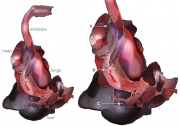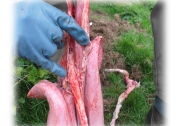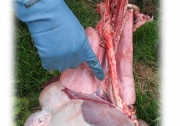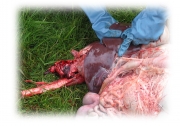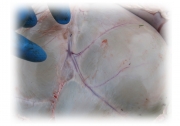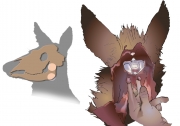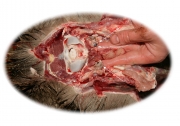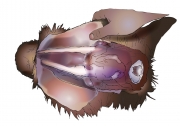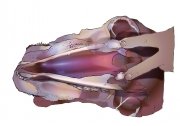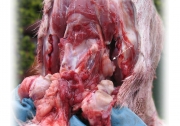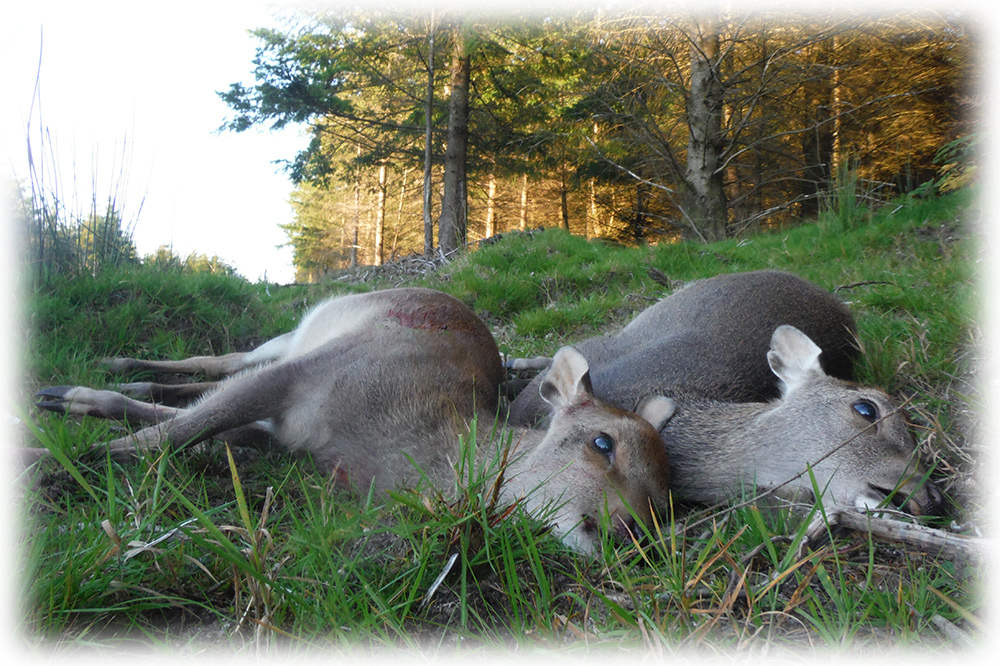
Introduction
The majority of deer carcasses are healthy and will become food. Inspection is carried out to remove the risk of diseased or contaminated carcasses entering the food chain, and can contribute to information on disease. This guide describes the carcass inspection process. (See also Disease and Gralloching guides)
Legislation
Food safety is the responsibility of all who shoot, dress, transport and process venison. Different parts of the legislation apply to different operations but there is a legal obligation on everyone to ensure that all food is safe to eat.
In addition it is a legal requirement for any wild game or wild game meat intended for sale to an approved game handling establishment (AGHE), to be inspected by a ‘trained person’ who must record and report:
- unusual behaviour in the animal before culling
- any abnormality observed in the gralloch, head and legs
- any condition which might lead one to suspect infection with a Notifiable disease
It is strongly recommended that, even where venison is intended for home consumption or sale directly to the final consumer, the carcass and organs are also subjected to a full inspection.
When in-skin carcasses are skinned and broken down for sale as venison or processed venison products, practices must be based on HACCP principles. Inspection of carcasses forms part of those practices.
Training
Practitioners should be properly trained to carry out carcass inspection. A ‘trained person’ must have sufficient knowledge and skill to identify any abnormal characteristics, behaviour or environmental contamination that would make a carcass or parts of it unfit for human consumption. Training and assessment to the appropriate standard is compulsory for all hunters selling venison to an AGHE. In the Republic of Ireland training is provided by the National Association of Regional Game Councils and certified by City and Guilds.
Inspection
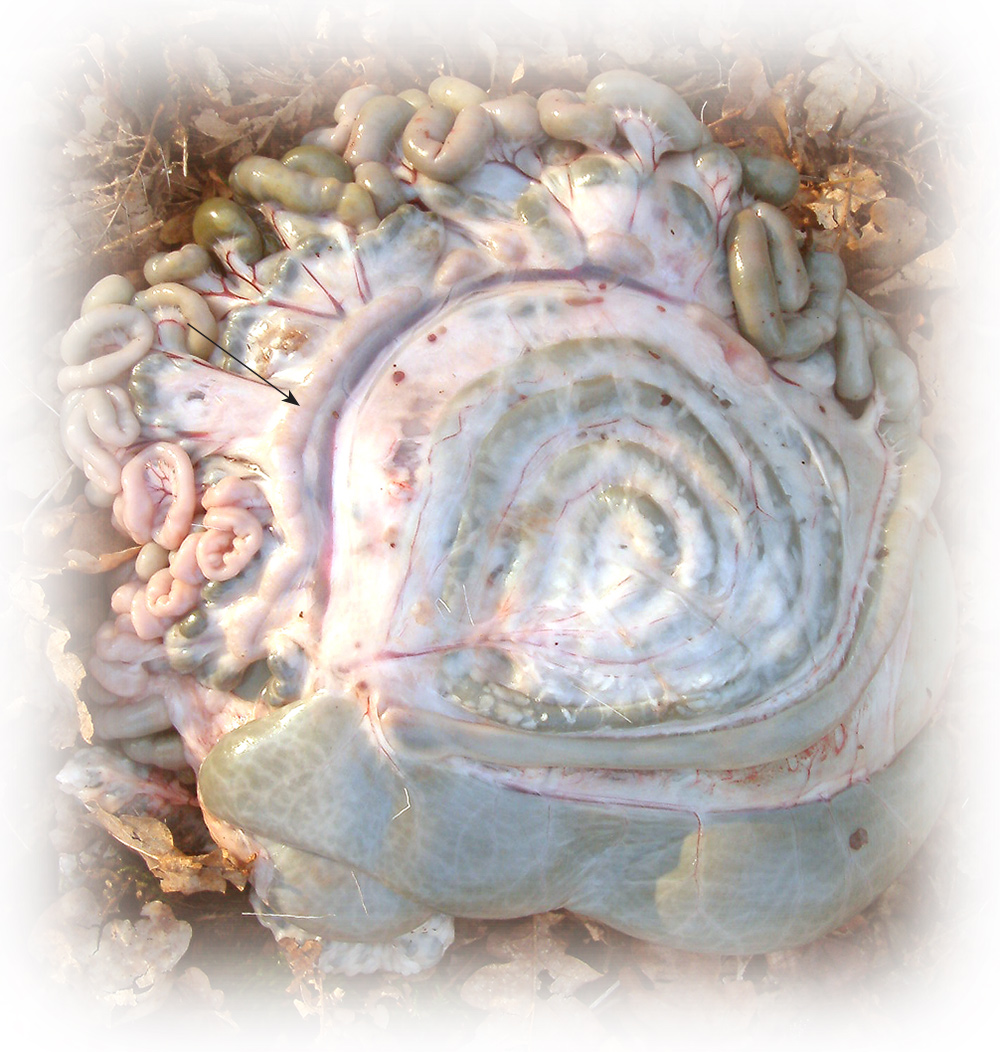
to find the mesenteric lymph nodes frill out the intestines on top of the rumen with the “cumberland sausage” side facing down
General
Key to the inspection process is a familiarity with what is normal and a knowledge of what to do when it is not, see Table 1.
Carcass inspection is a continuous process from observing the behaviour of the live animal just before shooting to the time that the carcass is stored for processing. It does not have to be carried out in a particular order but it is sensible to keep to as regular a routine as possible so that no part of the process is missed.
Part of the inspection procedure involves checking lymph nodes. The body’s lymphatic system acts as a filter for infection which will show up as swollen or pus (liquid or solid) filled nodes. Normal lymph nodes may vary in size and shape but are usually firm and a grey or pinky brown colour. It is recommended that lymph nodes are not cut during inspection.
Before shooting
- Take note of any abnormal behaviour, this must be recorded on a trained person declaration to an AGHE and should in any case give rise to concern that the animal may not be healthy.
- Make a mental note to check any abnormality that can be seen from a distance.
After shooting
- Check the animal is dead. Inspect the exterior of the carcass for obvious signs of a disease or injury e.g. broken bones, emaciation (indicated by poor flesh covering of the spine), severe diarrhoea, unusual excretions, weeping sores, major swellings, infected wounds.
- Check legs and feet for any swellings, sores or abscesses.
- Check the head, mouth, tongue and jaws for any swellings, blisters or abscesses.
During gralloch and carcass dressing
- Note any adhesions between the wall of the abdomen and the organs or between organs, unusual growths or cysts, or any unusual shape, size, texture, colouration or smell of the carcass or organs.
- After removing the stomach and intestines, inspect the spleen and gastric and mesenteric lymph nodes noting any enlargement or abscesses
- As the pluck is removed note any areas of discoloured or roughened surface on the inside of the chest wall (which may have originated from a wound associated with broken ribs), or any adhesions of the lungs to the chest wall, possibly indicative of the infectious condition causing pneumonia).
- Look for and note any lumps, abscesses, hardened areas or unusual discolouration in the organs of the pluck including the diaphragm. Lungworm or liver fluke may be visible in the respective organs.
- Look for and note any enlargement or abscesses within the bronchial, mediastinal and portal lymph nodes. (see next page)
- Remove any remaining parts of the alimentary tract, pluck, reproductive organs and inspect these.
Inspect the kidneys. Remove their fat envelope to check the colour, size and texture and the presence of abscesses or adhesions of the kidney to its envelope. Note any spots, cysts, blisters or white scars. - In the head look for and note any swelling of the retropharyngeal and sub-maxillary lymph nodes.
- Throughout the carcass there are many other lymph nodes including small dark coloured ones, often in chains. Note any abnormalities.
- Any unusual/excessive parasite burden is noteworthy in its own right, but may also be symptomatic of an underlying illness.
- Assess the general condition of the carcass. The most reliable aid to this is the percentage fat cover around the kidneys and the degree of musculature of the spine. The effects of season, age of the animal, lactation etc. should be taken into account when using it to judge the general health of the animal.
- If there are limited particles of contamination on areas such as the belly flaps or around bullet wounds, remove them by cutting back to clean flesh. Do not attempt to clean with water as this can spread contamination, discolour the carcass and encourage mould.
(above: click to see full image)
If abnormalities or contamination are found
The table below indicates the actions that should be taken if abnormalities are found. Bear in mind that there are ranges of “normality” and that deer vary in condition with age, sex and season. The requirement to notify the AGHE in a declaration is only relevant to carcasses intended for delivery there. Disposal of unfit carcasses and parts must always be in an approved manner (see By-product Disposal guide).
| Condition | Action |
|---|---|
| Carcass either severely emaciated, found dead, not killed by shooting, contaminated or otherwise unfit for human consumption | Abandon further processing /inspection unless required under disease outbreak rules. Leave in situ or dispose of in approved manner. Avoid contact with other carcasses. Disinfect equipment before re-using. Do not allow to enter food chain. |
| Suspected Notifiable disease | Notify District Veterinary Office (DVO) at DAFM as soon as possible. Isolate, and retain samples as instructed (if in doubt retain pluck and head in sealed plastic bags and keep with carcass). If carcass and parts are not required for further investigation dispose of in approved manner. |
| Suspected other disease | If the disease is known, not transmissible and the diseased tissue is localised ( e.g. liver fluke) remove infected parts and continue. Note abnormality and report on declaration to AGHE. If not, consider notifying DVO or dispose of in approved manner. |
| Organs of abnormal shape, colour, consistency, texture or with lumps, abscesses, hardened areas, spots, cysts, blisters, scars, inflammation, or adhesions. (abnormality restricted to organ only, rest of carcass appears normal) | Remove organ, Note abnormality and report on declaration to AGHE. If organ is edible offal – reject. |
| Lymph nodes enlarged or abscessed. Inspect bronchial, mediastinal, portal, gastric, mesenteric, sub-maxillary and retro-pharyngeal | If only a single node is involved, look for an injury, parasites or other cause. If there is no indication of Notifiable disease continue inspection. Note abnormality and report on declaration to AGHE. If the inflammation of nodes is throughout, suspect disease and follow appropriate procedure above. |
| Localised infection (swelling, abscess) | If it is a small area and the cause is visible(injury, external parasite etc) remove affected area and continue. Note abnormality and report on declaration to AGHE. |
| Adhesions (usually lungs or gut adhering to body wall but may be between organs) | If small, restricted to part of one organ or associated with injury remove organs and continue. Note abnormality and report on declaration to AGHE. If generalised treat as suspected disease. |
| Broken bones | For recent/non-infected breaks, remove affected part after skinning or note and report on declaration to AGHE. If there is generalised infection abandon further processing /inspection. Dispose of in approved manner. Avoid contact with other carcasses. Disinfect equipment before re-using. |
| Bruising/shot damage/visible contamination | If localised remove affected part back to undamaged flesh. Note and report on declaration to AGHE. If extensive and severe reject carcass and dispose of in approved manner. |
| Evidence of septic condition or fever | Abandon further processing/ inspection. If no evidence of Notifiable disease, dispose of in approved manner. Do not allow to enter the food chain. Avoid contact with other carcasses. Disinfect equipment before re-using. |
| Arthritis and Septic Arthritis | If only normal arthritic changes within joints with no associated infection, simply note on declaration. If joint and/or rest of carcass is septic, abandon inspection/processing and do not allow into food chain. Dispose of in approved manner. |
| “Fired” or “sweated” carcass | Abandon further processing/ inspection. If no evidence of Notifiable disease, dispose of in approved manner. Do not allow to enter the food chain. |
Records and traceability
Ensure that proper records are kept to ensure traceability. Much of this information should be included in normal larder records, see Larder Records form in the Associated Information section.
Carcasses supplied to an Approved Game Handling Establishment (AGHE) must have a declaration tag attached, on which must be any details of abnormalities found, or confirmation that they were not1.
Further Info
‘Safe Handling of Wild Game’ NARGC Training Manual and DVD produced by NARGC 2011.
Trained Hunter Course Registration: NARGC, Ferbane Business & Techology Park, Ballycumber Road, Ferbane, Co Offaly. 0906 457 757
[printfriendly]
